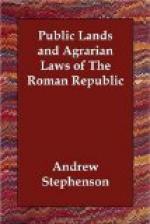CHAPTER I.
Sec. 1.—Landed property.
The Romans were a people that originally gave their almost exclusive attention to agriculture and stock-raising. The surnames of the most illustrious families, as Piso (miller), Porcius (swine-raiser), Lactucinius (lettuce-raiser), Stolo (a shoot), etc., prove this. To say that a man was a good farmer was, at one time, to bestow upon him the highest praise.[1] This character, joined to the spirit of order and private avarice which in a marked degree distinguished the Romans, has contributed to the development among them of a civil law which is perhaps the most remarkable monument which antiquity has left us. This civil code has become the basis of the law of European peoples, and recommends the civilization of Rome to the veneration of mankind.
The corner-stone of this legislation was the constitution of the law of property.[2] This property applies itself to everything in the law of Rome, to land, to persons and to obligations.
Urbs, the name of the village, takes its origin, according to an etymology given by Varro,[3] from the furrow which the plow traced about the habitations of the earliest dwellers. But what is of more interest to us is that the legal signification of Urbs and Roma was different. The former was the village comprised within the sacred enclosure; the latter was the total agglomeration of habitations which composed the village, properly[4] so called, and the outskirts, or suburbs. The powers of certain magistrates ceased with the sacred limits of the Urbs, while the privileges accorded to a citizen of Rome extended to the village and the suburbs and finally embraced the entire Roman world.
The most ancient documents which have reached us from the history of India and Egypt reveal that they had landed property fully established, while Roman annals reveal to us the very creation of this institution. Whatever modern criticism may deduce, Dionysius, Plutarch, Livy, and Cicero agree in representing the first king of Rome as merely establishing public property in Roman soil. This national property, the people possessed in common and not individually. Such appears to us to be the quiritarian property par excellence[5] and its primitive form was a variety of public community[6] of which individual property was but a later solemn emancipation. To this historic theory attaches the true notion of quiritarian land of which we will speak in greater detail hereafter.
As regards the organization and constitution of individual and private property, the traditions themselves attribute this to the second king of Rome, the real founder of Roman society, who divided the territory among the citizens, marking off the limits of individual shares and placing them under the protection of religion. In this way a religious charter was granted to the institutions of private property. Thus a primitive division of territory appears to have been the basis of these varied traditions, but the precise form of this division eludes us.




